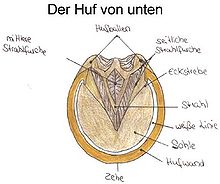thrush
The Thrush is a bacterial disease of the hoof in ungulates , particularly in horses . The soft horn of the hoof is decomposed by putrefactive bacteria. The main causes are poor posture and poor hoof care. Treatment is carried out after the deficiencies in husbandry have been eliminated by removing the damaged horn and using disinfecting solutions.
Symptoms
A putrefactive odor appears when the hooves are scraped out. Cavities, so-called pockets or cracks, which are filled with a greasy black mass, form in the jet . The horn becomes softer overall. In the advanced stage, when the horn disintegrates faster than it grows back, the beam can dissolve or become detached.
As a rule, thrush begins in the middle groove. From there it spreads to the lateral furrows and foci of putrefaction form throughout the frog. In the further course, it can also affect the ball of the horn, so that the horn is detached in shreds there and on the frog thighs until the dermis is exposed. If rot occurs on the white line , it is called horn rot .
Lameness occurs only in very advanced cases, when the exposed or only protected by thin horn is irritated by stones or sand and inflamed.
causes
The thrush is caused by putrefactive bacteria. Principal pathogen is Fusobacterium necrophorum , who also for foot rot is responsible of the sheep. The bacteria decompose the horn by forming cavities and rotting crevices. If the putrefaction process progresses faster than the ray horn grows back, the ray horn can completely decompose.
In order for thrush to occur, the triggering bacteria must find optimal environmental conditions for them. They need a warm, humid environment and can only reproduce in the absence of oxygen ( anaerobically ). The starting point of a thrush is usually in the middle groove. From there, the pathogens spread to the lateral furrows. In an advanced stage, thrush can lead to lameness due to dermis.
The cause of thrush is usually poor hoof care . Hoof care includes regular cleaning of the hoof with a hoof pick (at least once a day), as well as the correct cutting out of the hoof by a farrier or other hoof expert. This prevents zones from forming in pockets or cracks in the hoof (or simply under the dirt adhering to the hoof) that are closed off from the air supply and thus provide a breeding ground for anaerobic putrefactive bacteria. Another common cause is soiled boxes and paddocks, in which a mixture of faeces and urine provides the pathogens with a moist, warm and therefore ideal breeding ground. Too long heels or incorrect nailing with impairment of the hoof mechanism also favor the development of thrush.
Lack of exercise or exercise only on soft ground can encourage thrush to develop. When moving on hard ground - at least in the unshod horse - the beam touches the ground and presses against the dermis. This stimulates the blood circulation in the dermis and promotes the formation of new horns.
Finally, anatomical peculiarities of the hoof itself can favor the formation of thrush: Tight hoof positions and deep furrows make them easier to develop.
treatment
All treatment attempts fail if the contributing factors are not eliminated.
If thrush is present, the rotten horn parts must first be removed. If these cannot be completely cut away, because the rot has already eaten its way deep into the middle groove, the rot areas are treated with a disinfectant ( povidone iodine , hydrogen peroxide solution or zinc sulfate solution ). The use of iodoform ether (four to ten percent) is common, but also controversial .
If the rot is very severe, fungi are also often involved. In this case, the fungal agent enilconazole is applied undiluted with a brush to the affected beam for five days . If, after a five-day break, the jet still appears soft and gives off a bad smell, the treatment is repeated. In order to achieve extensive disinfection of the rotting crevices and to prevent renewed contamination of the attacked horn, these are often closed with tamponades made of cotton or gauze, which are changed at least once a day. Without this tamponage, the whole procedure has little chance of success. The hoof can also be cleaned with water and curd soap about once a week. It is also essential to cut out pockets and cracks in the jet as much as possible, every few days if possible.
In the case of poor (soft) hoof walls or a putrid frog area, pure vinegar should be used regularly (caution, do not use on open wounds!). Vinegar neutralizes the ammonia residues (NH 3 ) in the horse's sole area and counteracts the infestation of harmful bacteria, i.e. thrush. Vinegar also has the advantage that it strengthens the platelet structure of the horn walls and can therefore make a significant contribution to hoof health.
The thrush is often confused with a slightly frayed, renewing jet. If the stream doesn't really “smell like rotten eggs” and is exuding a greasy substance, it usually just needs to be trimmed flat and not treated.
literature
- Ronald J. Riegel: Image-text atlas on the anatomy and clinic of the horse: musculoskeletal system and lameness . Schlütersche 2006, ISBN 9783899930290 , p. 139.
- Horst Wissdorf: Adams' lameness in horses . Schlütersche 2008, ISBN 9783794402199 , pp. 540f.

